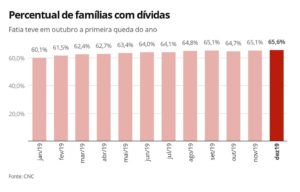Approximately two out of three families are in debt in Brazil.
In March, 66.2% of households are in debt (practically two out of every three of them). According to a survey released this Monday (30) by the National Confederation of Trade in Goods, Services and Tourism (CNC).
It is simply the highest percentage of the survey's historical series. That started in January 2010. The record until then had been registered in December 2019, when the percentage reached 65.6%.

The indicator covers several factors within the “debt” category. Such as, for example, the commitments made with post-dated checks, credit cards, overdrafts, store receipts, personal loans, car payments and insurance.
This survey presents indications that defaults also increased in March. The percentage of households with bills or debts in arrears rose from 24.1% in February to 25.3% in March.

While the total number of families who declared that they were unable to pay their bills or overdue debts and would therefore remain in default increased for the 2nd month in a row. Moving to 10.2%, compared to 9.7% in February.
National Confederation of Trade in Goods, Services and Tourism
“The data collection for this Peic took place between February 20 and March 5, prior to the week in which the covid-19 pandemic spread in Brazil. Even so, there is a deterioration in the default indicators, which will possibly intensify in the months ahead, as the trend is for consumers to find it more difficult to pay their bills without delay”, noted the CNC.
Izis Ferreira, economist responsible for the survey, also draws attention to the average share of income committed to debt. This reached 30% in the third month of that year. As well as for the proportion of families that declared themselves heavily indebted. Which has increased from 15% in February to 15.5% in March.
“Almost a third of household income is committed to debt, the highest percentage since December 2017. In families with incomes of up to ten minimum wages, the commitment to income has grown more significantly in the last three months”, he highlights.
For more information about economics, access.


